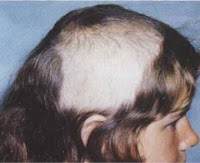Trichotillomania
Trichotillomania
Trichotillomania (trik-o-til-o-MAY-ne-uh) is an irresistible urge to pull out hair from your scalp, eyebrows or other areas of your body. Hair pulling from the scalp often leaves patchy bald spots, which people with trichotillomania may go to great lengths to disguise.
For some people, trichotillomania may be mild and generally manageable. For others, the urge to pull hair is overwhelming and can be accompanied by considerable distress. Some treatment options have helped many people reduce their hair pulling or stop entirely.
Signs and symptoms of trichotillomania often include:
- Repeatedly pulling your hair out, typically from your scalp, eyebrows or eyelashes, but it can be from other body areas as well
- A strong urge to pull hair, followed by feelings of relief after the hair is pulled
- Patchy bald areas on the scalp or other areas of your body
- Sparse or missing eyelashes or eyebrows
- Chewing or eating pulled-out hair
- Playing with pulled-out hair
- Rubbing pulled-out hair across your lips or face
Most people with trichotillomania pull hair in private and generally try to hide the disorder from others.
For some people, hair pulling is intentional and focused. They're aware that they're pulling their hair out and may even develop elaborate rituals for doing so. Other people pull their hair unconsciously. The same person may also do both, depending on the situation and mood. For example, focused hair pulling may occur when you're frustrated in the car. Or you may unconsciously pull hair when you're bored. Certain positions or rituals may trigger hair pulling, such as resting your head on your hand or brushing your hair.
Your doctor will perform a thorough evaluation to determine if you have trichotillomania, which may include examining how much hair loss you have, having you fill out a questionnaire and eliminating other possible causes of hair pulling or hair loss. In some cases, your doctor may also take a biopsy of your hair or skin to try to pinpoint the problem.
To be diagnosed with trichotillomania, you must meet criteria spelled out in the Diagnostic and Statistical Manual of Mental Disorders (DSM), published by the American Psychiatric Association.
DSM criteria for the diagnosis of trichotillomania include:
- Repeatedly pulling out your hair, resulting in noticeable hair loss
- An increasing sense of tension before pulling, or when you try to resist pulling
- Pleasure or relief when pulling
- Your hair loss isn't attributed to another medical or dermatologic condition
- Hair pulling causes you significant distress
There is some debate among mental health providers — and people with trichotillomania — about these criteria, and they may change in the future.
Research on treatment of trichotillomania is limited. Current approaches focus on:
Psychotherapy. A form of psychotherapy called habit reversal training may be an effective treatment for trichotillomania. This type of therapy helps you learn how to recognize situations where you're likely to pull and how to substitute other behaviors instead, such as clenching your fists for a period to "freeze" the urge, or redirecting your hand from your hair to your ear. Sometimes elements of other therapies may be blended with habit reversal training. For instance, your care provider may use cognitive therapy to help you challenge and examine distorted beliefs you may have in relation to hair pulling. Another treatment, acceptance and commitment therapy (ACT), helps people learn to accept their hair-pulling urges while at the same time teaching them how to avoid acting on their impulses.
Medications. Your doctor may also recommend that you take an antidepressant, such as clomipramine (Anafranil).




Comments
Post a Comment